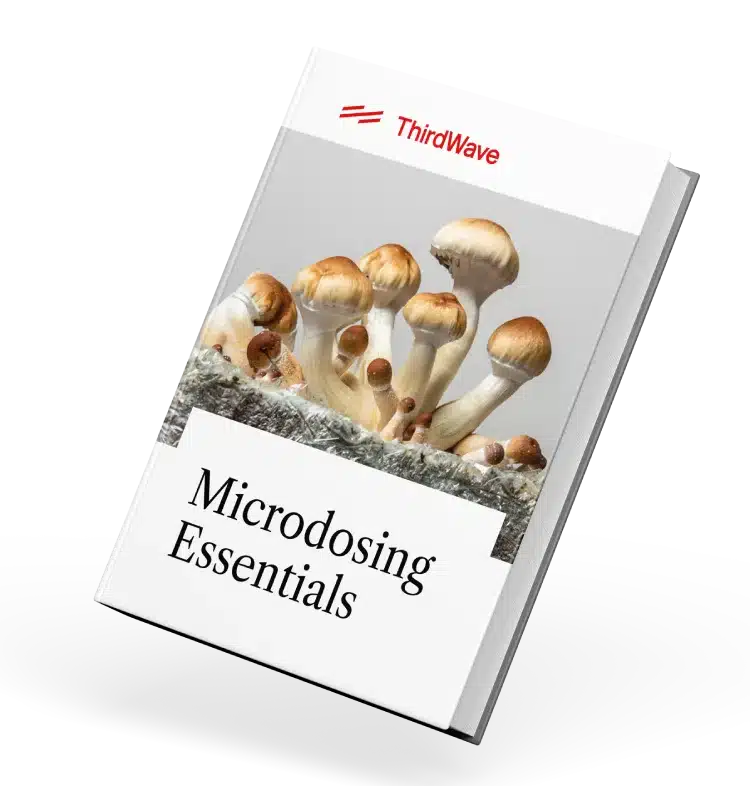Disclaimer: Psychedelics are largely illegal substances, and we do not encourage or condone their use where it is against the law. However, we accept that illicit drug use occurs and believe that offering responsible harm reduction information is imperative to keeping people safe. For that reason, this article is designed to enhance the safety of those who decide to use these substances.
Trauma can impact people’s mental and physical health and well-being their entire lives. Symptoms manifest as chronic pain, fatigue, depression, and nervous system dysregulation. Such deep-seated effects can be challenging to unravel. But psychedelics have proven effective healing catalysts through a concept called trauma release.
Trauma release is the process of discharging pent-up emotional and psychological stress stemming from painful experiences. The objective is to liberate the body and mind from the constraining grip of trauma, thereby restoring balance.
This article explores the relationship between trauma and psychedelics, signs of trauma release, and how to prepare for a safe and therapeutic experience.
Understanding Trauma and Psychedelics
Psychological trauma is the mental and emotional response to deeply disturbing or stressful events. These situations, often childhood trauma, involve a threat to physical safety and a violation of personal boundaries. The impact can disrupt a person’s sense of stability for years, often resulting in post-traumatic stress disorder (PTSD).
The bodily response to past trauma often involves nervous system dysregulation, causing a person to enter a state of constant “fight-or-flight” mode.
Such imbalances can manifest as:
- Upset stomach or Irritable Bowel Syndrome (IBS)
- Muscle tension
- Chronic fatigue syndrome
- Headaches
- Chronic pain
- Fibromyalgia
- Type 2 diabetes
- Heart disease
- Rheumatoid arthritis
- Other stress-related disorders
Trauma can also cause mental health struggles such as:
- Panic attacks
- Drug and alcohol misuse
- Difficulty managing emotions
- Self-harm
- Depression
- Anxiety
- Personality disorders
- Sleep disorders
When used in controlled, therapeutic settings, psychedelics can relieve trauma symptoms by facilitating profound emotional release and cognitive insights. Psychedelics like psilocybin, LSD, and MDMA fundamentally change how the brain works, helping patients confront and reframe traumatic memories, and thereby helping to release trauma.
For instance, psilocybin temporarily alters brain connectivity, facilitating introspective experiences that can restructure depressive thought patterns. This power provides a unique pathway for lasting depression relief. MDMA, on the other hand, invokes a strong sense of empathy and emotional safety, enabling patients to process traumatic memories without being overwhelmed by fear or anxiety.
A New Mexico-based study analyzed the effects of psychedelics and trauma release among Hispanic and American Indian/Alaska Natives (AI/AN) who experienced multigenerational trauma. The study found that psilocybin when administered within a psychotherapeutic framework, can invoke trauma release and resolve substance abuse issues.
However, psychedelic therapy can only be successful when patients feel physically and psychologically safe.
According to Dr. George Greer, a renowned psychedelic researcher, psychedelic psychotherapy frameworks must include:
- Careful informed consent
- A peer review process
- An inner-directed approach to psychotherapy
- Post-session integration practices
- Community-based participatory research
Signs Your Body is Releasing Trauma During a Psychedelic Experience
Trauma release during psychedelic experiences typically falls into three categories: emotional, physiological, and cognitive.
Emotional Signs of Trauma Release
Many trauma patients report feeling numb. Psychedelics can help reconnect them ”with deeply held emotions.”
Emotional signs of trauma release during psychedelic therapy include:
- Catharsis
Sometimes called emotional detox, catharsis can feel like a massive release of painful feelings, including pain, fear, pity, anger, or shame.
- Emotional release
Catharsis typically manifests as an intense emotional release accompanied by physical sensations like crying, shaking, or even laughter. It can feel like a weight being lifted.
- Revisiting traumatic memories
Many people experience flashbacks, memories, or visions of painful events. The process can feel challenging but often leads to profound insights and emotional release.
- Reframing the story
Psychedelics facilitate a state of neural plasticity, enabling people to re-examine traumatic memories with enhanced emotional and cognitive flexibility. This reframing often leads to enduring perspective shifts that can alleviate trauma-related symptoms.
Physiological Signs of Trauma Release
Physiological signs your body is releasing trauma during psychedelic therapy include:
- Increased heart rate and body temperature
Increased heart rate and body temperature can signify sympathetic nervous system activation, which commonly occurs during panic attacks. These physiological changes could also indicate the body is mobilizing its resources to confront stored emotional pain, potentially leading to the release and resolution of traumatic energy.
- Sweating and tremors
Hyperarousal symptoms like sweating and tremors can occur while the body retraces or re-experiences the trauma. These sensations can be disorienting, emphasizing the need for professional support.
- Physical tension
During a psychedelic experience, physical stress often manifests in localized muscle tightness, clenched fists, higher blood pressure, or shallow breathing, serving as somatic expressions of emotional trauma.
- Release of physical tension
As the journey progresses, this tension commonly reaches a peak and then abruptly loosens or relaxes, signifying a cathartic release. Emotional insights or breakthroughs often accompany the release.

Cognitive Signs of Trauma Release
Cognitive signs of trauma release among trauma survivors during psychedelic therapy often manifest as noticeable shifts in thought patterns.
Other cognitive indications include:
- Profound insights
During psychedelic experiences, people often view traumatic memories from a new angle. This perspective shift helps ignite awareness that can pave the way for healing and acceptance.
- Increased self-awareness
Deeper self-knowledge can feel like peeling back layers to reveal deeper truths about oneself. This state of heightened awareness is crucial for trauma release, as it allows people to understand the roots of their traumatic experiences.
- Acceptance
Traumatic events are painful. They can leave scars. But part of healing from trauma is acknowledging and embracing those scars. Psychedelics often allow people to accept what happened and move forward.
Potential Challenges and Best Practices
Self-administering psychedelics to facilitate trauma release is never a good idea. Patients should always seek a “safety net,” like a trusted friend or professional, to avoid adverse effects and maximize benefits.
- Avoiding Distressing experiences
Trauma release during psychedelic journeys can often mimic the painful experience itself. Without support, reliving trauma can trigger a “bad trip,” characterized by heightened anxiety, paranoia, and overwhelming distress.
- The importance of professional support and holistic practices:
Patients who work with trained psychedelic practitioners and utilize complementary practices like meditation, bodywork, and breathwork/deep breathing will be better prepared for a safe and meaningful experience.
- Set and Setting
Set and setting refer to a person’s internal emotional state (“set”) and the external environment (“setting”) where the psychedelic experience occurs.
An optimal “set” usually involves a state of mental preparedness, openness, and emotional stability, often achieved through pre-session counseling and intention-setting exercises.
The ideal “setting” is a comfortable, safe, and controlled environment, typically furnished with soothing aesthetics, dim lighting, and soft music, under the supervision of trained therapists.
Integration and Follow-Up
Many say that psychedelic experiences are among the top five most personally meaningful experiences someone has, alongside the birth of children and other peak and transformative events.
However, release during psychedelic journeys is only the first step in a long healing process. Patients must continue working with therapists or coaches afterward to integrate the lessons into lasting change.
Other techniques for integrating insights into daily life include:
- Journaling
- Support groups
- Psychedelic podcasts
- Yoga
- Meditation
- Art Therapy
- Spiritual practice
Integration practices are essential. Although psychedelic therapy delivers long-lasting benefits, depression often returns when patients do not continue doing the work.
The Bottom Line
Trauma release during psychedelic journeys is multifaceted, encompassing shifts in physical tension, cognitive patterns, and emotional responses. These signs serve as markers of the therapeutic process, guiding patients through the complexities of emotional healing. Physical symptoms like elevated heart rate may indicate the body’s readiness to confront stored past trauma. Cognitive shifts, characterized by new perspectives, are also key indicators.
Everything you need to know about Microdosing in one place
Download our FREE guide to learn how to begin a microdosing regimen, calibrate your dose level, and get the most out of your experience.

“This FREE Guide was just what I needed to take the first step into Microdosing. AND IT WAS THE BEST DECISION OF MY LIFE! After starting my microdosing regiment I now have more focus, energy and clarity into what it is I truly want in this world.”
James, New York

Everything you need to know about Microdosing in one place
Download our FREE guide to learn how to begin a microdosing regimen, calibrate your dose level, and get the most out of your experience.
An optimal set and setting and professional support are crucial in shaping therapeutic outcomes. All these elements merge to make psychedelic therapy a promising avenue for profound mental shifts.
If you or a loved one has endured trauma and want to try psychedelics, the best place to do so is in a stable environment with a trusted psychedelic therapist. At ThirdWave, we encourage you to make use of our directory to find professional psychedelic support near you.







